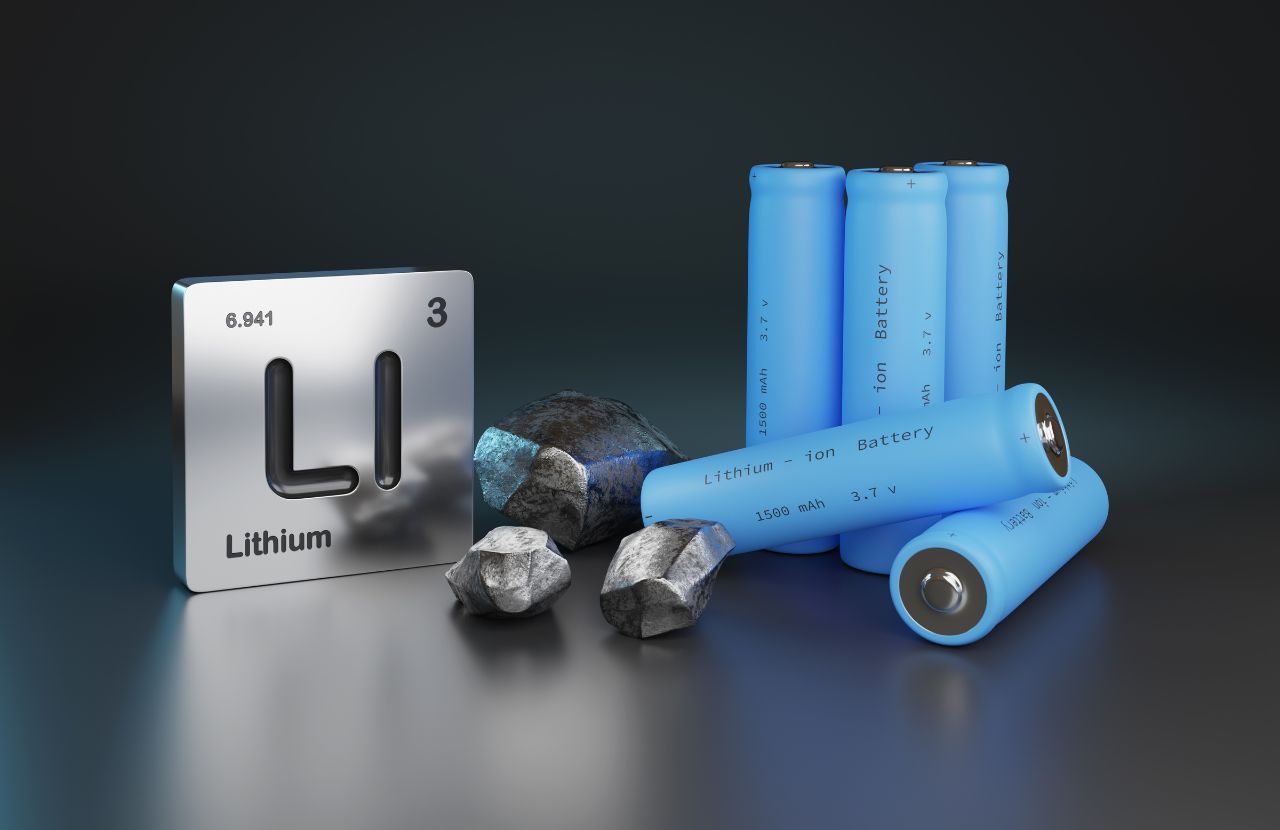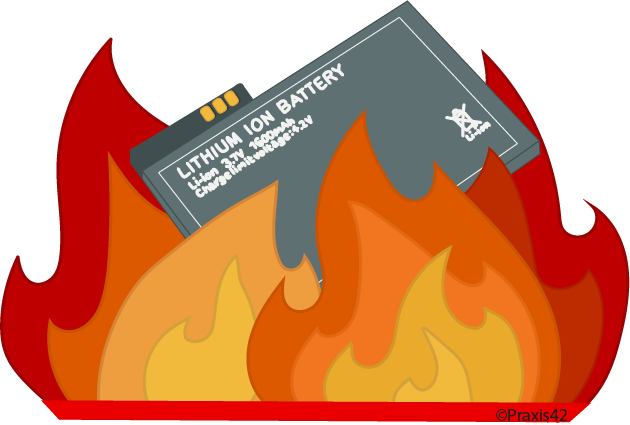
Lithium-ion battery fires increased by 46% between 2022 and 2023. Here we talk about the fire risk of lithium-ion batteries, how these fires can be prevented and what to do in an emergency.
Which devices are causing the most fires?
Lithium-ion batteries are found in a wide range of items, including e-bikes and e-scooters, e-cigarettes, laptops, tablets, mobile phones, hoverboards, electric toothbrushes and more.
Lithium-ion battery fires involving e-scooters and e-bikes doubled between 2020 and 2021. However, fires involving electric vehicles are extremely rare because electric cars are more heavily regulated than e-bikes and e-scooters and follow a different manufacturing process.
Lithium-ion batteries used in other devices are generally safe as long as they are stored, charged and disposed of correctly (see below).
Worryingly, lithium-ion battery fires at waste sites and in refuse lorries have increased more than 70% since 2022 according to the National Fire Chiefs Council (NFCC).
Why lithium-ion batteries catch fire
These are the primary causes of lithium-ion battery fires:

Thermal runway
If the battery’s internal components come into contact (for example the separator between the anode and cathode fails), it can cause a short circuit. This generates heat, which can lead to thermal runaway, where the battery rapidly overheats.
Physical damage to the battery can also cause a short circuit. If the battery is punctured or crushed, the internal structure can be compromised.
Charging a lithium-ion battery beyond its maximum voltage can cause excessive heat generation. Most batteries have built-in protection circuits to prevent this, but if these fail or are bypassed, it can lead to overheating.
Exposing lithium-ion batteries to high external temperatures can also cause them to overheat and potentially catch fire.
Manufacturing defects
The presence of tiny metal particles or other contaminants within the battery during manufacturing can cause internal short circuits.
Poor design or construction can lead to weak points in the battery, making them more prone to failure and overheating.
Improper use
Using a charger not specifically designed for the battery can potentially cause overheating.
Dropping, crushing, or otherwise physically stressing the battery can damage internal components, leading to failure.
Ageing
As lithium-ion batteries age, their internal components can degrade, increasing the likelihood of internal short circuits and other failures.
Environmental factors
Extreme cold or hot environments can affect the battery’s performance and stability. High temperatures, in particular, can accelerate the rate of chemical reactions within the battery, increasing the risk of thermal runaway.
Why are lithium-ion battery fires particularly dangerous?
Lithium-ion batteries have a high energy density, meaning they store a lot of energy in a small space. When they catch fire, the release of this energy can be very intense and difficult to control.
If a cell in the battery overheats, it can cause a chain reaction where neighbouring cells also overheat, leading to a rapid and uncontrollable rise in temperature. This thermal runway can result in the battery exploding or catching fire.
The electrolyte in lithium-ion batteries is a flammable liquid. When the battery is damaged or short-circuited, the electrolyte can ignite, contributing to the fire.
When lithium-ion batteries burn, they release toxic gases, including hydrogen fluoride and carbon monoxide. These fumes can be harmful to inhale and complicate firefighting efforts.
Even after a fire appears to be extinguished, a lithium-ion battery can reignite due to residual energy in the remaining cells.
What should you do in the event of a lithium-ion fire?
In the event of a lithium-ion battery fire, it is essential to act quickly and safely.
Evacuate the area
Move everyone away from the vicinity of the fire immediately to avoid inhaling toxic fumes and to protect against potential explosions.
Call emergency services
Call the emergency services and specify that the fire involves a lithium-ion battery. This will ensure that the responding team brings appropriate equipment.
Use the right fire extinguisher
Prioritise your own safety and only tackle a fire as a means of escape. Use a lithium-ion battery fire extinguisher, a Class D fire extinguisher designed for metal fires or a dry powder extinguisher.
If the fire involves an electric car, a fire extinguisher will not work, and the fire must be tackled by the emergency services. An EV car fire blanket may be used to contain the fire until the emergency services arrive.
Isolate and cool the battery
If it is safe to do so, move the burning device to an isolated, non-flammable area to prevent the fire from spreading. Use long tools to avoid getting too close to the flames, being mindful about protecting your eyes as well as your skin.
Although water is not recommended for electrical fires because water conducts electricity, in the case of lithium-ion battery fires, flooding the battery with water can help to cool it and prevent thermal runaway. However, ensure the power source is disconnected first to prevent an electric shock.
Ventilate the area
If you are indoors, open windows and doors to ventilate the area and disperse toxic fumes. Ensure that everyone remains upwind of the smoke.
Monitor the battery
Even after the fire appears to be extinguished, continue to monitor the battery, as it can reignite. Do not assume the fire is completely out until the battery has been cooled and inspected.
Seek medical attention
If anyone has been exposed to smoke or fumes, seek medical attention immediately. Toxic gases released from lithium-ion battery fires can be harmful.
Dispose of the battery safely
Once the fire is out and the battery is cool, ensure it is disposed of properly (see below).
How can lithium-ion battery fires be prevented?
Quality
Purchase all lithium-ion devices from reputable manufacturers and suppliers.
When buying e-bikes and e-scooters ensure they have a CE or UKCA quality mark. Always check to make sure your bike or scooter hasn’t been recalled for safety reasons by checking the government’s product recalls and alerts website.
See the Department for Transport’s battery safety guidance for e-cycles, or battery safety guidance for e-scooters.
Damage
Do not use batteries or devices that show signs of swelling, leaking, overheating, or mechanical damage (cracked, dented, punctured, or crushed).
Smoke alarms
Fire England recommend ensuring that a smoke alarm is installed in areas where devices are charged or stored and test them once a month to make sure they work.
Charging
- Do not charge batteries or devices on beds, sofas, or carpets. Keep them away from highly flammable materials such as blankets, clothing, and paper.
- Once the indicator shows that the battery is fully charged, disconnect it from the charger. Do not over-charge the device as this can lead to overheating.
- Avoid leaving batteries or devices unattended while charging.
- Never use and charge devices such as phones, tablets, and e-cigarettes in bed, as they can overheat if you fall asleep.
- Only use chargers supplied with the equipment or device.
- Check chargers for signs of damage before use. Never use a charger that is damaged in any way.
- Charge larger batteries and equipment, like power tools and electric scooters, away from living spaces.
- Do not charge or store battery devices near exits or along egress paths where they might block your escape in case of a fire.
Storage
Never store or leave batteries and devices in areas where they can be exposed to heat or moisture. Do not leave devices in direct sunlight or parked vehicles where they can quickly heat up.
Disposal
Lithium-ion batteries must not be put straight into rubbish bins and must be taken to a local recycling centre’s electrical collection point.
Lithium-ion battery safety training
Our lithium-ion battery safety training raises awareness of lithium-ion safety risks, how to prevent lithium-ion battery fires and what to do in an emergency. This online course takes about 30 minutes to complete at the learner’s own pace.
Please visit the lithium-ion battery safety training webpage to find out what the course covers or contact our friendly team for advice.

Rob Sherman
Director of Fire Safety
